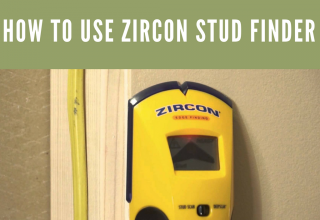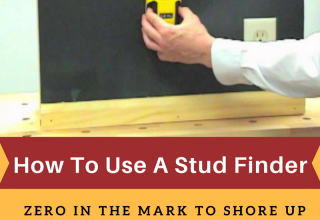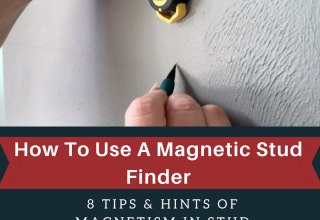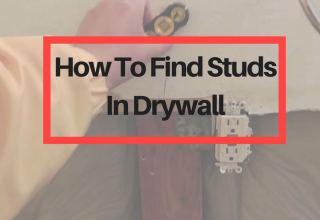
Before the advent of automatic stud navigation tools, contractors and DIY homeowners would resort to the old tricks of the trade. Though some of the techniques hit the mark, you could go close but no cigar missing the target. Today’s technologies pack endless stud-detection inventions coming down the pike.
Magnetic stud finder pioneered and spearheaded modern devices. Capacitive finders will do the job by sensing density fluctuations in a wall.
At the top of the heap, micropower impulse radar technology has a significantly greater scope than capacitive stud sensors. They can ravel out studs several inches deeper than their competitors. But locating studs depends on the system or mechanism integrated in the device.
Things To Consider about How Does a Stud Finder Work
1. Troubleshooting Tips & Tricks for using Stud Sensors
You can observe a few simple tricks to avoid wasting chunks of time with the device.
Ensure the power grid or batteries will keep the stud finder up-and-running for the task.
Timber studs or beams leave an outline near a window and door to support the substructure securely, start by scouring here.
If you suspect AC live wiring beneath the walling veil, tool up with a stud detector that traces wires to avoid electrocution or property damage
Stud-finding depends on logic, knowledge of construction plan and instincts, a little patience will uncover targets
Read and implement the manufacturer’s instructions on how to use the device
2. Electronic Finders Sample Changes in Density to Hit Studs
Electronic stud sensors home in variations in an electrostatic field or density if a target lies beneath. The lower reading suggests the existence of a stud underneath the wall. Capacitive stud detectors also boast scanning capability to locate rebar, pipes, AC voltage, and metal.
- They detect with pinpoint precision and indicate edges, centers and locations of multiple studs simultaneously
- They can pierce the walling veil layers beneath to 3” deep. Deep Scan mode provides an improved view of targets beneath the wall
- Wire-warning alerts show the existence of live, unsheathed electrical wire buried deeply underneath
- Metal Scan mode finds non-ferrous and ferrous metals for thicker plaster walls
3. Capacitive Edge Stud Finders
Capacitive edge-finders hone in the edges of a stud or other component beneath the wall. They sense a fluctuation in density when it’s directly above the edge of a stud.
The accuracy of this device will improve if you place it above an edge with the spacing between the surface and layers beneath it change quickly.
Calibrate the device above a stud-less portion of the wall, and then drag it across the surface until you detect a fluctuation in density to hit the edge of a stud.
The finder may not avoid all red herrings; it can indicate a point an inch or more from the target’s edge. Once you mark the edges of the stud, you can work out its center easily.
4. Capacitive Center Finders
Center stud finders shine through the task by pinpointing once you hit the midpoint above a surface. The device measures a wall’s dielectric constant at an equidistant to hone in the center.
- Center stud finders hit the bull’s eye by utilizing dual sensors that capture separate readings of a surface’s dielectric constant. If two readings correspond, the tool indicates it has latched onto the center of the stud.
- Move the device in either direction and recalibrate. Rugged textures can cause awkward movement along the wall inhibiting the calibration data. The varieties of readings help you determine the target’s center.
5. Capacitive Instant Stud Sensors
Instant stud detectors rely on an internal capacitor equipped with several sensory plates that immediately reports on the center, edges or multiple targets by computing an algorithm.
- Instant stud sensors do not require moving along the surface to nail down a target, they surpass the obstacles of crooked wall texture for a quicker, more accurate readings.
- The tools sense different regions of a walling in one fell swoop including the midpoint, edges and locations with no targets.
- Advanced multi-scanner finders feed into projected displays varying widths of targets and the site of multiple studs all at once.
6. Magnetic Stud Detectors: Stationary vs. Moving Sensors
i. Stationary Magnetic Finders
- Stationary magnetic stud finders have a small stationary magnet to sense the nails and screws hammered into studs while erecting the walling structure.
- You move it around the surface until the sensation of magnetic pull hints the direction of the pull.
ii. Moving Magnetic Finders
- Moving magnetic stud sensors have a neodymium magnet suspended within a compartment but free to move in response to covered metal.
- For walls with superficial fasteners, the magnet leaps towards the surface with such speed that it produces a unique thud sound once it contacts the wall. Deep fasteners generate a softer sound due to the slower movement. You don’t need to feel the pull making it ideal for fasteners ensconced deep in plaster or tile.
7. Micropower Impulse Radar (MIR)
Radar detectors come with a transmitter to emit many small pulsations of radio waves angled at targets that reflect them back into a receiver reporting wood, pipes or electrical wiring. MIR uses extremely short electromagnetic vibrations to spot objects within a smaller scope. MIR sensors can hone in timber and steel studs in a wall, AC live wire, steel in concrete and plumbing lines.
- The sensor uncovers the location, timing and other relevant readings of the reflected radio waves to register the material found.
- They provide a scalpel-precise depiction of objects underneath with greater scanning range and depth several feet beneath a surface.
8. Bag of Tricks for Operating
- For magnetic stud sensors the pull becomes stronger as you inch closer to the metal in the concrete
- Hold the tool in your hands up and avoid body contact
- Keep the device steady with one hand with a pencil or marking tool with the other
- Grasp the device parallel to the lining of the walling, move it along horizontally sideways and highlight the location of edges and centers of the targets
- You can measure out 16” or 24” increments from the point of the studs found
- Tap the wall lightly to detect a dull, less quiet and resonant sound to verify the presence of a stud
Final Verdict
Our in-depth guide offers a mine of information for DIYers. But exactly How Does a Stud Finder Work to probe deep into the wall and detect targets?
The handheld devices identify framing studs nestled beneath the lining of a wall powered by unique technologies like internal capacitors found in electronic stud finders. To avoid investing in an all-show-and-no-go stud finder, purchase a model designed to scan multiple materials with a variety of settings.
Some newer inventions on the horizon like RF Radar integrating 3D imaging capability have made the stud-hunting task easy duck soup.
High-end instant stud finders sample multiple readings to compute the location of targets making them less prone to construction anomalies such as uneven plaster that can distort the midpoint or edge of studs.

















Leave a Reply